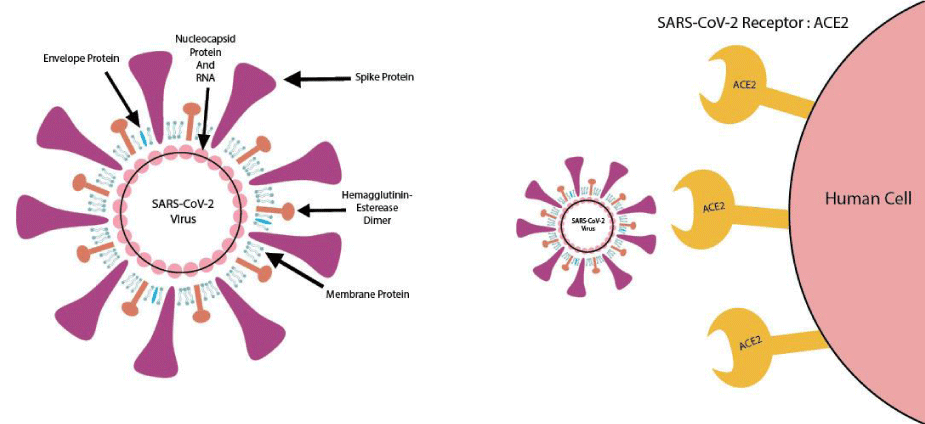Archive of Biomedical Science and Engineering
COVID-19 aerosols and droplets and their entry into lung alveoli
Bingmei Fu1 and Sheldon Weinbaum2*
2Professor of Biomedical Engineering, The City College of New York, USA
Cite this as
Fu B, Weinbaum S (2020) COVID-19 aerosols and droplets and their entry into lung alveoli. Biomed Sci Eng 6(1): 041-042. DOI: 10.17352/abse.000020We have been asked by friends, many who are not scientists, how far droplets from a sneeze, cough or breathing travel before they disappear largely through evaporation or just simple settling in an indoor environment. Basically, how does the virus spread in indoor environments and how effective are masks. Which particles penetrate deep into your lungs, and why do your lung capillaries become leaky? These are not simple questions because they depend on temperature, relative humidity and most importantly the initial size of the droplet or aerosol. Where does the 6 feet separation distance come from?
First, how big are the droplets in breathing, a cough or a sneeze, and what is their exit velocity? When you sneeze, the exit velocity can be as high as 30 meters per second (30 m/s, 67 mph), when you cough, as high as 25 m/s, but more typically 10 m/s, and when you breathe, 1.5 m/s. However, a single cough can release up to 3000 droplets. It is comforting to know that in a cough, 99% of the droplets are < 10 µm and 90% are less than 1 µm (1 µm or 1 micron is 1/1000th of a millimeter, a red cell is 8 µm, a fine human hair 40 µm). Thus only 30 droplets, 1% of 3000, are > 10 µm and large enough to travel far. Let’s put this in the perspective of a surgical mask and a high quality N95 mask. A simple surgical mask screens particles larger than 5 µm. These are typical of the larger spherical droplets from a cough or sneeze. In contrast, the particles in breathing are typically < 1 µm and they are called aerosols, not droplets, and they are concentrated in the range of 0.3 to 0.7 µm. An N95 mask will capture nearly all aerosols in this range and even fine aerosol mist particles as small as 0.1 µm. This is largely through electrostatic attraction much like running a comb through your hair and picking up small pieces of tissue. It is clear from this size range that a simple cloth or even surgical mask is essentially useless for aerosols since they are < 1 µm. What they do stop are the large droplets in coughing and sneezing. These large droplets would travel quite far if it were not for a simple mask. A recent study by an MIT group (https://jamanetwork.com/journals/jama/fullarticle/2763852)
Showed that droplets and aerosols generated by a sneeze can reach one meter in a fraction of a second and up to 8 meters in less than 6 seconds. Compared to not wearing any face covers, wearing a simple mask by a healthy person can reduce the risk of infection by 30% even when surrounded by a COVID-19 patient. If the patient wears a simple mask, it can reduce the contamination by 95%. If both wear simple masks, the risk of infection is only 1.5%.
Where does the 6 feet social distancing guideline come from? During normal breathing, the droplets and aerosols from one person can travel 0.8 meter. The distance between two persons would be 1.6 meters, or about 6 feet (1.8 meters). Another theory is that the spread of viruses is largely based on the spread of large droplets > 5 µm when you sneeze or cough. This is based on the fact that depending on the temperature and humidity, droplets as large as 60 to 100 µm will basically evaporate before they have traveled 2 meters. This is where the 6 feet or 1.8 meter separation distance comes from since few droplets exceed even 50 µm. The smaller the droplets, the shorter distance they travel. There is also the often cited claim that the disease will greatly subside in the summer months when the temperature is high outdoors. However, in the summer the humidity is also high and evaporation is much slower.
How quickly does a droplet or aerosol settle in a room indoors? This is based on something called Stokes law for low Reynolds number flow, the motion of particles in water or air when inertia is not important. A one micron particle will fall 5 feet, the distance from your mouth to the ground in 12 hours. The math here is very simple since the settling velocity increases as the square of the droplet radius. A 10 µm droplet will settle 100 times quicker than a 1 µm aerosol or take only 7 minutes. This comparison has huge implications. Aerosols never settle since they are nearly all < 1 µm. They just hang in the air and drift until they evaporate. In contrast, the bigger droplets 10 µm or larger will nearly all settle on surfaces where the virus can easily cling to your finger tips because of their moisture much like finger prints on a mirror. A recent report in the NY Times (4/20/2020) emphasized that the life of the virus is much shorter on porous materials like clothes or a newspaper than smooth surfaces like metal or plastic.
Which is more dangerous? The 10 µm or larger droplets or the far more numerous aerosols? Part of the answer to this question lies in the virus content of the droplets, since the largest droplets are few in number and their origin comes from the deeper part of the lung where the disease manifests itself in the alveolar sheets where the pulmonary capillaries are inflamed. Is the virus a surface phenomenon where the virus particles lie on the surface of the droplet or is the virus spread nearly uniformly through the droplet volume? We do not believe this question has been resolved because of the important role of surfactants in reducing the surface tension in breathing. Clearly large droplets would play a more important role if the virus was distributed throughout the volume of the droplet and not just its surface.
There recently has been a significant change in thinking of the relative importance of aerosols and droplets in indoor environments since aerosols can stay in the air almost indefinitely, especially in humid air. Our own belief is that aerosols are the more sinister intruder for two reasons. First, in closed spaces like unventilated corridors and elevators, the aerosols never settle whereas the droplets have largely landed after a few minutes. Second, when an aerosol or droplet enters your airways, where will it eventually settle? Large droplets will impact the wall of your bronchial tubes and never go deeper into the lung because their momentum will cause them to crash into the sidewalls of your smaller air ducts. In contrast, aerosols are much more easily carried into the deeper part of your lung since they have little momentum and go all the way to your alveoli (air sacs). These are 250 µm air sacs that look like grapes hanging on a vine. You have 300 million of them and their surface area is an amazing 70 m2. The walls of the air sacs are thin 5 µm sheets containing fine capillaries where your blood releases your CO2 and absorbs the O2 that has entered your lungs.
In many of the most severe cases of COVID-19, the patient’s blood has high levels of immune system proteins called cytokines. When our body is infected by virus or bacteria, the cells in our body will sense that there is something invading and bad. The cells will secrete cytokines to inform the immune cells for their help. Some cytokines can kill the infected cell which is a protective mechanism so it doesn’t spread to other cells (virus can only replicate in live cells). However, when many cells are killed at the same time by the cytokines, which is called cytokine storm, the tissue will be damaged. In COVID-19 patients, the most damaged tissue is in the lung. One explanation for this is that because the COVID-19 aerosols are directly inhaled through the nose and mouth, they are largely deposited in the lower airways or alveoli. The spike proteins on the surface of the virus bind to their receptor, ACE2, on the cells forming the alveolar wall and infect these cells (https://www.promocell.com/news/news-announcement/study-and-fight-coronavirus-with-research-tools-from-promocell/). On the outer surface of alveoli, there are many capillaries with thin walls. The virus may enter the blood through the infected (damaged) cell lining and thereby further compromise the capillary wall. The compromised capillary wall is leaky, allowing the fluid from the blood to fill the alveoli, starving the blood of oxygen. Although how the capillary wall becomes leaky is unknown, one possibility is that the cytokines induced by the virus can disrupt the endothelial surface coating of capillaries, a protective layer called the endothelial glycocalyx, similar to the cytokines induced by bacteria and cancer cells.
It is widely recognized that COVID-19 has a very high fatality rate for seniors and patients with basic diseases. The endothelial glycocalyx covers the inner surface of all the blood vessels. It plays a crucial role 1) in sensing the blood flow and regulating the blood perfusion to different organs and tissues, 2) in preventing the interaction between circulating cells (red blood cells, white blood cells, platelets, cancer cells) and endothelial cells forming the vessel wall, and 3) in maintaining the normal nutrient and waste exchange between the blood and tissue. This layer has already experienced preexisting damage in the elderly and patients with basic diseases such as cardiovascular disease and diabetes. If the cytokines induced by COVID-19 virus further damage this layer, the vessel can no longer sense the blood flows, resulting in mal-regulation of blood perfusion and death of tissues due to lack of nutrient supply and waste removal. The vessel walls also become leakier and the circulating cells bind to the vessel wall to form thrombi, all of which affect the fatality rate.
This work is partially supported by NIH grant 1UH3TR002151-01
Article Alerts
Subscribe to our articles alerts and stay tuned.
 This work is licensed under a Creative Commons Attribution 4.0 International License.
This work is licensed under a Creative Commons Attribution 4.0 International License.


 Save to Mendeley
Save to Mendeley
